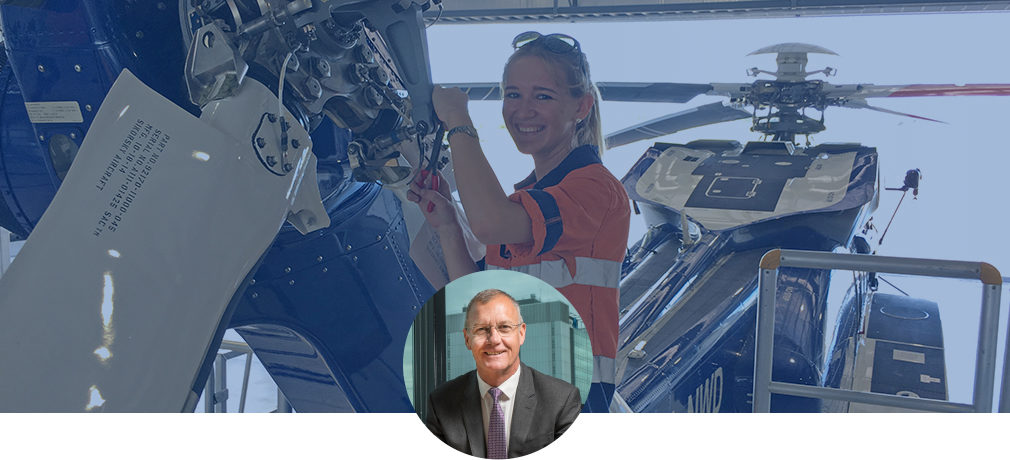David Ruff
CEO Babcock International Group, Australia & New Zealand
The views reflected in this article are the views of the author and do not necessarily reflect the views of Babcock International Group or those affiliated with it.
The designer and builder of the SEA 1000 Future Submarines program, Naval Group, has publicly stated its intent to achieve a 50:50 gender ratio in its eventual 2,500-strong workforce. Now, that’s a bold declaration in what is currently a heavily male-dominated industry. But, I believe Australia can achieve gender parity in delivering its world-class submarine-building capability; and what an example that would be to the rest of the ‘First World’ – who, the evidence suggests, don’t always walk-the-talk.
My diversity epiphany
Oddly enough, I first came across the power of gender balance in the British military. Having been through officer training at Sandhurst, served with the Royal Marines and operated in various conflict zones around the world, my initial experience of leadership was distinctly macho; indeed, at that time, women were simply not allowed to serve on the ‘Front Line’.
But then, I was appointed to a desk job in the UK, heading up the entity responsible for the British military’s combat support vehicle fleet. My new organisation was largely staffed by public servants, many of whom were female, including two members of my Board, the CFO and the Commercial Director.
This was a bit of a cultural transition for me; first, I needed to adjust to working with public servants – as distinct from soldiers, sailors, Marines and airmen. Next, I quickly realised that not only was my CFO one of the most competent people I had ever worked with but, in fact, my very ‘survival’ in my new role largely depended on her. And it wasn’t just about her competence as a CFO; the balance that her style of leadership – including risk management – brought to the Board meant that, overall, the team operated more cohesively and effectively than it otherwise would have. I very quickly realised you should measure a person’s value by what they deliver – not who they are, or what they look like.
Why we need female engineers and leaders
Since joining Babcock in 2007, I’ve seen increasing numbers of female engineers and leaders in action, including the talented female executives on the Babcock Australasia leadership team. I am always struck by their very different approach to solving problems which, in my experience, often gets a better long-term result.
Why? In my experience, it’s because women usually do two things better than men:
- Women take time to understand the whole problem. Men tend to kick the door down to get some light on the problem, and then leap on the problem to solve it. Whereas, women are more likely to carefully take down the door, the windows and the walls, so they can look at the problem from several different angles before formulating a solution. It might be a bit slower, but the result is often better.
- Women instinctively look at a situation from the other person’s perspective. That’s something I, as a male, have had to consciously learn how to do. For example, in my early corporate days, I didn’t see too much problem in being five minutes late for a meeting; I was busy, can’t you see? But then my wife – who’s actually taught me more about the finer points of leadership than I ever learnt in the military – explained to me that every time I was late, I was saying to those waiting people: “My time is more important than yours; your time (and you) don’t matter as much as me.” I was horrified at the thought that I had been ‘telegraphing’ such a message; I now make it my business to try and see everything from the other person’s perspective, first.
Now, I’m not saying that we don’t need men in the mix; it’s simply that you get better results when you have a diverse set of approaches to solving challenges – whether they be technical, leadership or operational problems.
How to achieve gender parity in vocational training
If Australia is going to achieve gender parity in its submarine-building capability, I can recommend the approach Babcock takes in our UK vocational training academies. Babcock is Britain’s largest vocational training provider, with around 23,000 students, developing the technical & engineering skills required to work in industries such as automotive, rail, energy and defence.
When I first joined Babcock and came across these institutions, the engineering stream was mostly male. A decade later, women are now not only making up a high proportion of those students but, in our own graduate entry scheme, the top 3 or 4 students in each cohort over recent years have been female.
How did we achieve this? Babcock took three deliberate steps:
- Start early, in primary and secondary education – This won’t be news to anyone trying to get girls interested in STEM subjects, but you need to win over female hearts and minds, early. Girls continue to be put off engineering because of its ‘masculine’ reputation. But they will be inspired and motivated if you show them a high-flying female engineer doing meaningful work, for great companies, around the world.
- Guarantee a job – This is Babcock’s ‘employment-led training’ model: every student entering a Babcock-run academy is either employed by our customer when they start the training, or they are guaranteed a job on completion. 100% of our vocational graduates leave with a job – a huge drawcard for smart female school leavers, who understand that qualifications are not just about certificates.
- Test for attitude, as well as aptitude – This is critical. It really separates the boys from the girls, so to speak. Because our graduates are being trained for a job in a specific company, our recruitment processes include tests for attitude and cultural fit with that company. We use a range of tests and processes to ensure our graduates will be team players and future leaders. With their often higher emotional intelligence, women do well on these tests, which helps to ensure gender parity at intake.
What this approach tends to prove is that focusing on quality, competency and attitude promotes gender parity, without needing to set quotas, or other potentially divisive mechanisms.
Achieving a balanced submarine-building workforce
So, as a submarine engineer with a global pedigree, Babcock is highly supportive of the 50:50 gender target Naval Group has set. I personally believe it is eminently achievable – and, in fact, essential. Australia will only deliver its submarine-building industry by drawing from the full pool of local talent: women and men of every culture and from every background.

